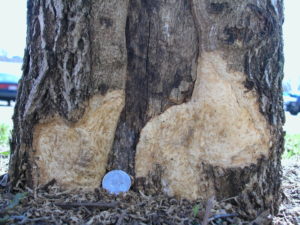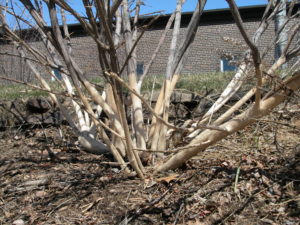By Todd Lanigan, forest health specialist, Eau Claire, Todd.Lanigan@wisconsin.gov, 715-210-0150
With the onset of spring and snow melt, you may have noticed bark missing at the base of trees and shrubs. This is most commonly noticed on sections of bark that were below the snow line. This damage, known as girdling, was caused by mice and rabbits feeding on the bark during the winter.

Mouse girdling damage at base of tree surrounded by older greyish-black wound.
Some rabbit damage can also be seen 3-6 feet high on tree and shrub branches. These branches would have been bent down by the weight of the snow and buried underneath where the rabbits were able to take advantage of this additional food source.

Rabbit damage on shrubs.
I have reports from the northeastern part of the state that squirrels are also causing damage to trees. Squirrel damage has been observed in tree canopies where the bark has been stripped from the trunk and branches. This type of damage can occur on both hardwoods and conifers. Some conifers, like pines, are damaged when squirrels chew off the bark from galls that are caused by fungal diseases like gall rust. Hardwoods, like sugar maple, are damaged when squirrels chew off the bark to uncover the sugary sap below. It seems squirrels enjoy maple syrup as well.

Squirrel damage on gall rust.
If a tree, shrub or branch is completely girdled so that no bark remains, the plant will die from that point on. Depending on the species, and health of the plant at the time of girdling, sprouts may develop from the root system and lead to new growth. If the girdling is incomplete, the plant will produce callus tissue that eventually grows over the girdling wound, healing the area in the process.
For more information on fungal galls on pine, see Linda Williams’ recent article on eastern pine gall rust in this issue.
